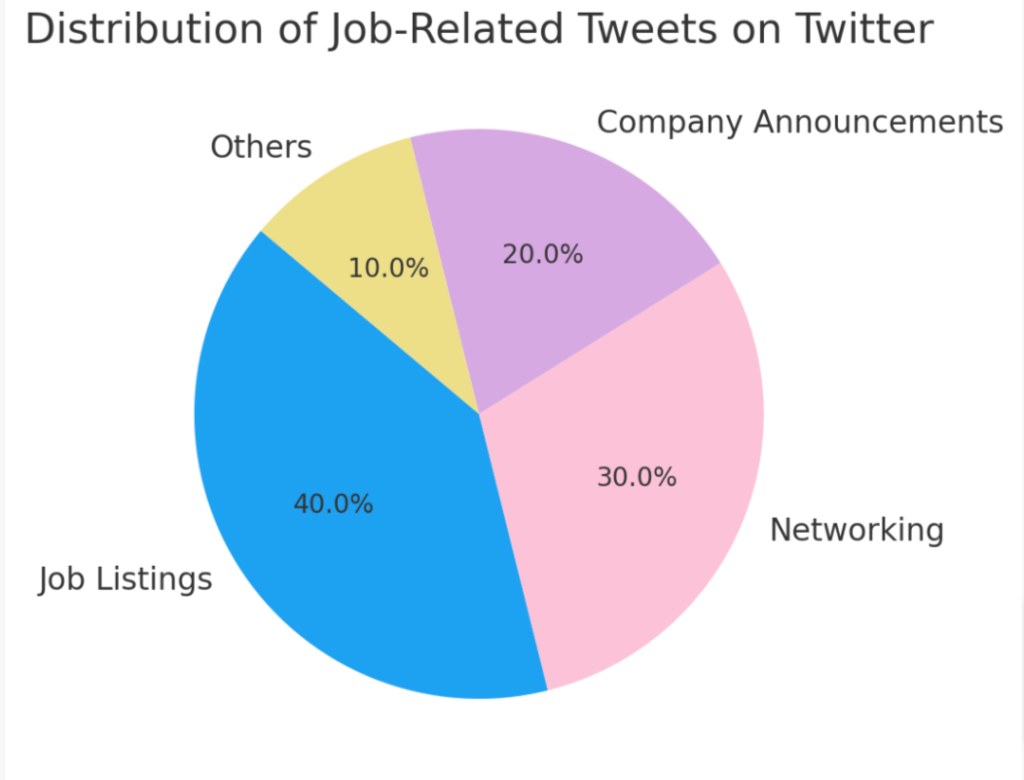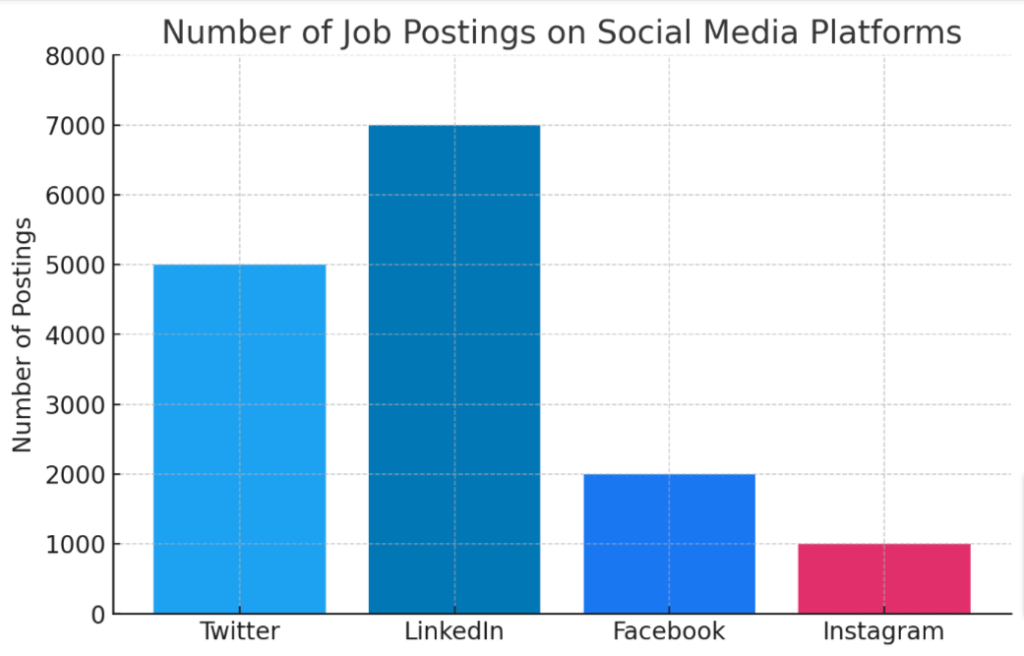Harnessing Twitter: Strategies to Boost Your Remote Job Hunt
Introduction
In the digital era, the quest for job opportunities has evolved remarkably. Gone are the days when job hunting was limited to newspapers’ classified sections or word-of-mouth referrals.
Today, the digital landscape offers a myriad of platforms and tools, enabling job seekers to connect with opportunities from around the globe, all from the comfort of their homes. Among these platforms, social media has emerged as a frontrunner, breaking down traditional barriers and opening doors to a plethora of opportunities.
And while platforms like LinkedIn might be the first to come to mind when considering professional networking, there’s another social media giant that’s making waves in the job search arena: Twitter.
With its real-time updates, vast user base, and dynamic engagement opportunities, Twitter has transformed from a platform known for 280-character thoughts into a potent tool for job hunting. Especially for those seeking remote opportunities, Twitter offers a unique blend of informality and reach, providing a platform where job listings meet personal interactions, and where companies’ official announcements are intertwined with casual chats.
For the uninitiated, the idea of Twitter as a job search tool might seem unconventional, perhaps even daunting. But for those in the know, Twitter represents a goldmine of opportunities, connections, and insights.
This article aims to demystify the role of Twitter in the remote job search journey, offering strategies, tips, and insights to help you navigate the platform effectively and harness its potential to land your dream remote role. Whether you’re a Twitter novice or a seasoned tweeter, by the end of this guide, you’ll view the platform in a new light: not just as a space for news or memes, but as a powerful ally in your professional journey.
Understanding the Unique Position of Twitter in the Job Search Ecosystem
At first glance, Twitter, with its fast-paced feeds and character limitations, might seem like an unlikely candidate for job hunting. But delve a bit deeper, and you’ll discover that its very nature is what sets it apart in the job search ecosystem.

Quick Statistics on Twitter’s User Base and Engagement
Twitter boasts over 330 million monthly active users, making it one of the world’s most popular social media platforms. Every day, about 500 million tweets are sent, covering a wide range of topics from news and entertainment to personal anecdotes and professional updates. This vast and diverse user base offers a rich tapestry of networking opportunities, insights, and potential job listings.
Comparison with Other Platforms Like LinkedIn and Facebook
While LinkedIn is undeniably the go-to platform for professional networking and job hunting, it tends to be more formal, structured, and, at times, saturated. Facebook, on the other hand, is primarily a personal social network, and while it does have job listing features, it’s not the primary focus.
Twitter strikes a unique balance. It’s less formal than LinkedIn, allowing for more genuine and spontaneous interactions, yet more professionally geared than Facebook. This blend creates a dynamic space where companies can post job listings in the same feed as their latest product announcements or industry insights.
The Informal and Real-Time Nature of Twitter Interactions
One of Twitter’s defining characteristics is its real-time nature. Tweets are instant, and interactions happen in the moment. For job seekers, this means immediate access to the latest job listings or company announcements. The platform’s informality also allows for more genuine interactions. You can directly tweet to a company’s CEO, engage with a brand’s latest campaign, or join a trending discussion about remote work challenges. This mix of immediacy and authenticity positions Twitter as a unique tool in the remote job seeker’s arsenal.
In essence, Twitter’s blend of vast reach, real-time interactions, and a balance between formality and casual engagement makes it a potent platform for job hunting. For remote job seekers, it offers a space where they can not only discover opportunities but also engage with potential employers, industry peers, and thought leaders in a way that’s both genuine and strategic.
Building a Professional Twitter Presence for Job Hunting
While Twitter offers immense potential for job seekers, tapping into this potential requires more than just casual tweeting. It’s essential to craft a professional presence that not only showcases your skills and experiences but also resonates with potential employers and industry peers. Let’s explore how to build a Twitter profile tailored for remote job hunting.
Choosing a Professional Username and Profile Picture
Your Twitter handle (or username) and profile picture are often the first things people notice. Ensure your handle is professional, ideally a variation of your name. If you have a common name and your preferred handle is taken, consider adding your profession or industry, like @JaneDoeWriter or @JohnDoeDesign.
Your profile picture should be clear, high-quality, and professional. While it doesn’t need to be as formal as a LinkedIn photo, it should present you in a positive, approachable light.
Crafting a Compelling Bio that Highlights Your Skills and Remote Work Aspirations
With only 160 characters for your bio, every word counts. This space should succinctly encapsulate your professional identity and aspirations. For instance:
“Digital marketer with 5+ years of experience. Passionate about remote work. Helping brands grow online. Currently seeking remote opportunities.”
Additionally, utilize the website section to link to your LinkedIn profile, online portfolio, or personal website.
The Importance of a Pinned Tweet: Showcasing Your CV, Portfolio, or a Key Achievement

A pinned tweet sits at the top of your profile, ensuring it’s the first tweet visitors see. Use this feature to showcase something significant:
- A link to your online CV or portfolio.
- A notable achievement or project.
- A tweet stating that you’re seeking remote opportunities, along with a brief overview of your skills.
For instance: “? Remote social media strategist with 6 years of experience. I’ve helped brands boost engagement by 50%+. Currently on the lookout for new opportunities. Let’s connect! #RemoteJob #SocialMediaExpert”
Crafting a professional Twitter presence is akin to designing a digital business card. It’s a snapshot of who you are, what you bring to the table, and what you’re seeking. By optimizing your profile and strategically leveraging features like the pinned tweet, you position yourself as a serious, skilled, and approachable professional, ready to harness the opportunities the Twitterverse offers.
Navigating Twitter for Remote Job Opportunities
With your professional Twitter profile set up, the next step is to actively seek and engage with remote job opportunities on the platform. Twitter’s vast and dynamic landscape offers numerous avenues to discover these openings, but it requires a blend of proactive searching and strategic engagement. Let’s dive into the methods to navigate Twitter effectively for your remote job search.
Using Hashtags Effectively (#RemoteJob, #HiringNow, #RemoteWork, etc.)
Hashtags are a cornerstone of Twitter, helping categorize content and making it discoverable. For job seekers, they serve as a gateway to potential opportunities:
- Regularly search for hashtags like #RemoteJob, #RemoteHiring, #WorkFromHomeJobs, and other relevant tags.
- Create a list of industry-specific hashtags, such as #TechRemoteJobs or #SocialMediaJobs, to narrow down openings in your domain.
- Engage with tweets under these hashtags. Even if the specific role isn’t a fit, following and interacting with companies or recruiters posting these listings can lead to future opportunities.
Following Accounts Dedicated to Remote Job Listings
Several Twitter accounts are dedicated to posting remote job listings across various industries. Some notable ones include:
- @remote_ok
- @WorkingNomads
- @weworkremotely
By following these accounts, you ensure a steady stream of remote job listings appear in your feed. Engaging with these tweets, either by liking, retweeting, or commenting, can also increase your visibility among other job seekers and employers.
Engaging with Companies Known for Remote Work Culture
Many companies are renowned for their remote-friendly work cultures, such as Buffer, Trello, and Automattic. Engaging with these companies on Twitter can be beneficial:
- Follow their official accounts to stay updated with job postings and company news.
- Engage with their content, showcasing genuine interest in their work culture and values.
- If they post about job openings, even if it’s not in your domain, consider retweeting or commenting to show your enthusiasm for the company. Recruiters often appreciate such engagement and may keep an eye out for future interactions.
In the vast world of Twitter, opportunities are aplenty, but they often require a proactive approach. By leveraging hashtags, following dedicated job listing accounts, and engaging with remote-friendly companies, you can stay abreast of the latest openings and position yourself as a top contender in the remote job market. Remember, on Twitter, every interaction is a potential networking opportunity. Approach your job search with enthusiasm, authenticity, and strategy, and you’ll be well on your way to unearthing the perfect remote role.
Networking and Building Connections on Twitter
Beyond just job listings, one of Twitter’s most potent offerings is its networking capabilities. In the realm of remote work, where face-to-face networking events might be rare, Twitter provides a platform for genuine, real-time interactions with industry peers, thought leaders, potential employers, and more. Let’s delve into how you can maximize Twitter for networking as you seek remote roles.

Engaging with Industry Leaders and Influencers
Every industry has its set of thought leaders and influencers who share insights, trends, and discussions that shape the domain:
- Identify and follow key influencers in your industry.
- Engage with their content by commenting, retweeting, or sharing. This not only showcases your genuine interest but also positions you on their radar.
- Don’t shy away from starting discussions or asking questions. Many influencers appreciate engaged followers and often respond, leading to meaningful conversations.
Joining Twitter Chats Related to Remote Work and Your Industry
Twitter chats are scheduled discussions centered around a specific hashtag. They offer a platform for like-minded individuals to discuss topics, share insights, and network:
- Identify and participate in Twitter chats related to remote work, such as #RemoteChat or #WorkFromHomeChat.
- Engage in industry-specific chats to connect with peers and showcase your expertise.
- Be active, genuine, and respectful during these chats. They’re an excellent opportunity to make connections and even get noticed by potential employers.

Building and Nurturing Relationships Over Direct Messages
While public interactions are essential, Twitter’s Direct Message (DM) feature allows for more personal conversations:
- If you’ve had consistent, positive interactions with someone, consider reaching out via DM to introduce yourself and express genuine interest in their work.
- Use DMs to seek advice, share resources, or even inquire about potential job openings. However, always ensure your messages are respectful and not overly intrusive.
- If someone reaches out to you, be prompt and courteous in your responses. Building a positive rapport can lead to referrals, recommendations, or job leads.
Networking on Twitter is both an art and a science. While it’s essential to be strategic, it’s equally crucial to be authentic. Remember, every tweet, like, retweet, or message contributes to your professional narrative on the platform. By actively engaging, initiating discussions, and building genuine relationships, you not only enrich your Twitter experience but also significantly enhance your prospects in the remote job market. In the digital realm, connections are currency, and Twitter offers a treasure trove of networking opportunities waiting to be harnessed.
Sharing and Engaging with Relevant Content
While seeking and applying for jobs is a significant aspect of your Twitter strategy, another critical component is sharing and engaging with content. This not only positions you as a knowledgeable and active industry player but also keeps you informed about the latest trends and discussions. Let’s explore how to effectively share and engage with content on Twitter to bolster your remote job search.
Showcasing Your Expertise Through Tweets, Threads, and Shared Articles
Your tweets can serve as mini-showcases of your expertise:
- Share insights or opinions on the latest industry trends.
- Write Twitter threads on topics you’re well-versed in, breaking down complex ideas into digestible tweets.
- Share articles or resources that you find valuable, adding your take or summary to provide additional value to your followers.
Engaging with Content from Potential Employers or Industry Leaders
Interacting with content from companies or individuals you admire can increase your visibility and demonstrate genuine interest:
- Thoughtfully comment on tweets, adding your perspective or asking relevant questions.
- Retweet content that resonates with you, adding a comment to give it a personal touch.
- Share industry news or updates, tagging relevant companies or individuals, and offering your insights.
The Importance of Consistency and Authenticity in Your Twitter Interactions
Regular engagement is key to maintaining an active and visible presence:
- Set aside time daily or several times a week to engage with content on Twitter.
- Avoid the trap of only sharing or commenting when you’re actively job hunting. Consistent engagement, even when not looking for a job, establishes credibility and genuine interest in your industry.
- Always be authentic in your interactions. While it’s okay to have a strategy, ensure your engagements aren’t robotic or overly calculated. Genuine interactions resonate more and can lead to meaningful connections.
Sharing and engaging with content on Twitter is a two-fold strategy. It keeps you updated with the latest in your industry while also positioning you as an engaged, knowledgeable professional. By offering value through your tweets and interactions, you not only build a compelling professional narrative but also increase your chances of catching the eye of potential employers or collaborators.
Remember, on Twitter, your content is a reflection of your expertise and passion. Craft it with care, engage with purpose, and let it amplify your voice in the bustling digital realm of remote job opportunities.
The Do’s and Don’ts of Job Hunting on Twitter
As with any platform, there are etiquettes and best practices to follow on Twitter, especially when job hunting. While the platform offers immense potential, a single misstep can also hinder opportunities. To navigate the Twitter job search landscape effectively, it’s essential to understand the do’s and don’ts.
Keeping Your Interactions Professional and Respectful
Do: Maintain a professional tone, especially when interacting with potential employers, recruiters, or industry peers. Remember that while Twitter is informal, it’s still a public platform.
Don’t: Engage in heated debates or aggressive confrontations, even if you disagree with someone. It’s essential to keep discussions civil and constructive.
Avoiding Controversial or Divisive Topics
Do: Stay informed and engage in discussions that align with your professional interests.
Don’t: Dive into controversial or polarizing topics, especially if they don’t pertain to your industry. Such discussions can alienate potential employers or connections.
The Importance of Proofreading and Ensuring Clarity in Your Tweets
Do: Proofread your tweets, especially those related to job hunting or professional insights. Ensure they’re clear, concise, and free from typos.
Don’t: Rush to tweet without reviewing. A poorly crafted tweet can create an unfavorable impression.
Being Transparent and Authentic
Do: Be genuine in your interactions, share real experiences, and showcase your authentic self.
Don’t: Exaggerate your skills, experiences, or achievements. In the digital age, information is easily verifiable, and authenticity is valued.
Respecting Privacy and Boundaries
Do: Engage in public discussions, retweet interesting content, and DM when you’ve established a rapport or have a genuine reason.
Don’t: Overwhelm individuals with unsolicited DMs, especially if they haven’t indicated openness to such messages. Respect boundaries and avoid coming off as intrusive.
In the dynamic world of Twitter, where interactions are swift and far-reaching, understanding the do’s and don’ts is crucial. By maintaining professionalism, authenticity, and respect, you can effectively harness the platform’s potential without falling into common pitfalls.
Remember, your Twitter presence is an extension of your professional identity, and every tweet, interaction, and engagement contributes to the narrative you’re building. Approach your job hunt on Twitter with strategy, but also with genuine enthusiasm and integrity. The platform is not just a space for opportunities but a community, and by being a valuable, respectful member, you pave the way for myriad remote job prospects.
Leveraging Twitter Tools and Features for Your Job Search
Twitter, at its core, is designed for real-time communication and engagement. However, as the platform has evolved, so have its features and the third-party tools that complement it. For remote job seekers, leveraging these tools and features can significantly enhance the job search experience, making it more streamlined, efficient, and effective.
Utilizing Twitter Lists to Curate Content and Job Listings
Twitter Lists allow users to curate a feed based on specific users or criteria, helping to organize and prioritize content:
- Create a List specifically for job listings by adding accounts that frequently post remote opportunities.
- Have another List for industry influencers, helping you stay updated with the latest trends and discussions.
- Lists ensure you don’t miss critical tweets amidst the bustling main feed.
The Role of Twitter Analytics in Understanding Your Reach and Engagement
Twitter Analytics provides insights into how your content is performing:
- Monitor which tweets garner the most engagement, helping you understand what resonates with your audience.
- Track your follower growth, engagement rates, and other metrics to refine your Twitter strategy.
- Understanding your analytics can guide your content strategy, ensuring you’re sharing and engaging in ways that enhance your visibility and credibility.
Exploring Third-Party Tools for Job Hunting on Twitter
Several tools can enhance your Twitter experience, especially in the context of job hunting:
- TweetDeck: A comprehensive Twitter dashboard that allows you to monitor multiple feeds simultaneously, perfect for tracking various job-related hashtags or lists.
- Buffer or Hootsuite: These tools let you schedule tweets, ensuring consistent engagement even when you’re not online.
- Advanced Search: Twitter’s built-in feature, which lets you fine-tune your searches, helping you find job listings or discussions relevant to your domain.
Twitter, in its essence, is a powerful platform for networking, engagement, and job hunting. However, when complemented with its built-in features and third-party tools, its potential magnifies. By leveraging these tools, remote job seekers can curate a more efficient, effective, and strategic job search journey on the platform.
Whether it’s staying updated with curated content, understanding your engagement metrics, or scheduling tweets for consistent visibility, these tools empower you to harness Twitter’s potential fully, bringing you closer to your dream remote job.
Real-life Success Stories: Landing Remote Jobs Through Twitter
The power of Twitter in the remote job search landscape isn’t just theoretical; numerous individuals have tapped into the platform’s potential and secured their dream roles. These real-life success stories serve as inspiration, showcasing the tangible outcomes of strategic, genuine engagement on Twitter.

Sarah’s Story: From Engaging Threads to a Remote Content Strategist Role
Sarah, a budding content strategist, regularly shared insights about content trends on Twitter. One day, she started a thread dissecting a viral marketing campaign. Not only did her thread garner significant engagement from her followers, but it also caught the attention of a SaaS company’s CEO, who was impressed with her analysis. A few DMs later, Sarah was in talks for a remote content strategist role with the company. Her consistent, insightful Twitter presence led her directly to an opportunity.
Alex’s Narrative: The Power of Hashtags and Direct Engagement
Alex was on the hunt for a remote developer role. He routinely checked the hashtag #RemoteDevJobs and came across a tweet from a startup looking for a developer with a specific skill set that matched his expertise. Instead of just sending an email application, Alex responded directly to the tweet, showcasing a project he’d recently completed that utilized the required skills. The startup was impressed with his proactive approach and portfolio, initiating an interview process that eventually led to a job offer.
Priya’s Journey: Networking Leads to Referrals
Priya, a digital marketing enthusiast, frequently engaged with industry leaders on Twitter. Over time, she built a rapport with several of them. When one of these connections came across a remote job listing in a company newsletter, they immediately thought of Priya and shared it with her via DM. Priya applied and, with a referral from her Twitter connection, secured the role. Her active networking on Twitter led to a personal referral, showcasing the platform’s power in building genuine relationships.
These success stories underscore the myriad ways Twitter can pave the path to remote job opportunities. Whether it’s through insightful content, direct engagement with job listings, or the power of networking leading to referrals, Twitter’s dynamic landscape offers numerous avenues to success. For job seekers, these narratives serve as motivation, proving that with the right strategies, authentic engagement, and a touch of proactivity, Twitter can indeed be the bridge to their next professional milestone.
Conclusion
The digital transformation of the job market has opened up avenues that were previously unimaginable. In this era, where remote work is increasingly becoming the norm, platforms like Twitter have emerged as powerful allies for job seekers. No longer just a space for news updates or casual banter, Twitter now stands as a dynamic hub of opportunities, networking, and professional growth.
For the remote job seeker, the platform offers a unique blend of immediacy, reach, and genuine interaction. From discovering job listings in real-time to engaging directly with potential employers, from showcasing expertise through insightful threads to building meaningful connections that lead to referrals, Twitter’s potential is vast and multifaceted.
However, like any tool, the impact of Twitter lies in its usage. A casual, sporadic approach might yield occasional insights, but a strategic, consistent, and authentic presence can transform the platform from a mere social media site to a powerful catalyst in one’s remote job search journey.
In essence, Twitter represents the convergence of the modern job market’s elements: the immediacy of the digital age, the authenticity valued by today’s employers, and the global reach of remote work. By understanding its nuances, leveraging its tools, and engaging with purpose and passion, job seekers can turn Twitter into their personal portal to the world of remote opportunities.
As the lines between work and digital identities blur, platforms like Twitter stand as testament to the evolving nature of job hunting. Embrace its potential, engage with authenticity, and let Twitter be the bridge to your next remote role. The world of opportunities awaits, and with the right strategies in place, your dream job might just be a tweet away.
Additional Resources
As you embark on your remote job hunting journey on Twitter, equipping yourself with the right resources can make all the difference. Here’s a curated list of tools, accounts, and articles to enhance your Twitter job search experience.
Must-follow Twitter Accounts for Remote Job Seekers
- @jobspresso: Regularly posts high-quality remote jobs in tech, marketing, customer support, and more.
- @remotiveio: A great source for remote job listings and insightful articles on remote work.
- @RemoteWorkHub: Shares remote job opportunities and tips on thriving in remote roles.
Recommended Tools and Plugins to Enhance the Twitter Job Hunting Experience
- Followerwonk: An analytics tool to dive deep into Twitter analytics, understand follower demographics, and optimize your engagement.
- Tweepi: Helps you engage with users relevant to your industry, potentially increasing your followers and reach.
- Pocket: A handy tool to save articles or job listings you come across on Twitter to read or apply later.
External Articles and Guides on Optimizing Twitter for Professional Networking and Job Searching
- “The Ultimate Guide to Using Twitter for Professional Networking” by Social Media Examiner: A comprehensive guide that delves into building a professional Twitter profile, engaging with industry leaders, and more.
- “How I Landed My Dream Job Through Twitter” by Forbes: An inspiring read on leveraging Twitter for job opportunities with practical tips.
- “Twitter Networking: How to Use Twitter to Find a Job” by The Muse: Offers actionable insights on using Twitter as a networking tool in your job search.
Twitter, with its vast landscape and dynamic interactions, can be overwhelming. But with the right resources at your fingertips, you can navigate it with confidence and strategy. Whether it’s staying updated with the latest job listings, optimizing your engagements, or diving deep into expert insights, these resources can significantly bolster your Twitter job search experience.
Remember, in the digital age, continuous learning and adaptation are key. Equip yourself with the right knowledge, engage with purpose, and let the world of Twitter unfold its opportunities before you.

